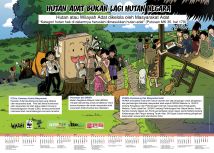Sabah Explorations!
There it was that tree with the big red pods!
Sterculia megistohpylla is a decorative plant with lovely red pods that can grow big enough to hold your lunch! Sterculia species are known to produce latex, or can even be used as laxatives, while others have seeds that are used in traditional Chinese medicines as coolants (Malva nut).
Joanna and I were spending our last moments in Sandakan, Sabah walking through the Rainforest Discovery Center. Though we didn’t have that much time before our flight we were happy to have the opportunity to visit the Center framed around a serene lake showcasing rainforest finds for visitors. One interesting display was “Spices from the Rainforest!” complete with a self-service smelling station! Let’s hope more come to their senses with such educational experiences on the importance of our rainforests for food, economy, life!
We were in Sandakan actually to meet the Sabah Forestry Department to explore collaborations on the second phase of our Swiss supported program with the ASEAN Social Forestry Network. The meeting with Deputy Director Frederick Kugan was an opportunity to share knowledge and experiences on NTFPs and social forestry in general. According to Mr Kugan and his team, some of the key NTFPs in Sabah would include forest honey, rattan, bamboo, wild durian and medicinal plants, though development of these products was still in their infancy stage. There was mention that there had been efforts at the community level on NTFP development but this lacked interagency coordination.
NTFP-EP also shared the experiences of building the capacity of communities in managing and marketing NTFP resources. Department staff mentioned that efforts were made on prohibiting the felling of the Tualang tree that housed wild bee-hives across the state. They also mentioned that NTFP-EP with its wide network in forest honey development could assist in improving quality and product development in forest honey, among other NTFPs.
The meeting concluded with agreement from both parties to continue discussions on developing activities between NTFP-EP and Sabah Forestry Department on potential sites and efforts, in collaboration with various NGOs and networks in the state.
We thank our host from Sabah Forestry Department, Mr. Ricky Martin, the forester… not the singer, for our productive and fun-filled morning in Sandakan. We will definitely be back for more Sabah explorations!


